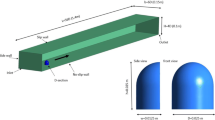Abstract
Unsteady supersonic base flows around three afterbodies, cylindrical (Cy), boattailed (BT) and three-step (MS), are investigated in this paper. Reynolds-averaged Navier–Stokes (RANS) and two RANS/LES (large-eddy simulation) hybrid methods, detached eddy simulation (DES) and delayed-DES (DDES), are used to predict the base flow characteristics around the baseline Cy afterbody. All the RANS and hybrid methods are based on the two-equation SST (shear-stress transport) model with compressible corrections (CC). According to the comparison of measurements, both DES and DDES can produce more satisfactory results than RANS. RANS can only present the “stable” flow patterns, while the hybrid methods can demonstrate unsteady flow structures. DDES and DES results are little different from one another although the latter exhibits better agreement with the experiment. DES is taken to investigate the 5° BT andthree-step afterbodies. The mean flow data and the instantaneous turbulent coherent structures are compared against available measurements.
Similar content being viewed by others
References
Mathur T., Dutton J.C.: Velocity and turbulence measurements in supersonic base flow with mass bleed. AIAA J. 34, 1153–1159 (1996)
Hemin J.L., Dutton J.C.: Supersonic near-wake afterbody boattailing effects on axisymmetric bodies. J. Spacecr. Rockets 31, 1021–1028 (1994)
Ruffin S.M., Gupta A., Marshall D.: Supersonic channel airfoils for reduced drag. AIAA J. 38, 480–486 (2000)
Viswanath P.R.: Drag reduction of afterbodies by controlled separated flows. AIAA J. 39, 73–78 (2001)
Mathur N.B., Viswanath P.R.: Drag reduction from square-base afterbodies at high speeds. J. Aircr. 41, 811–820 (2004)
Herrin J.L., Dutton J.C.: Supersonic base flow experiments in the near wake of a cylindrical afterbody. AIAA J. 32, 77–83 (1994)
Bourdon C.J., Dutton J.C.: Planar visualizations of large-scale turbulent structures in axisymmetric supersonic separated flows. Phys. Fluids 11, 201–213 (1999)
Zhang, H.X., Li, Z.W.: Numerical simulation of hypersonic laminar wake. Acta Mech. Sin. 24, 389-399 (1992) (in Chinese)
Suzen, Y.B., Hoffmann, K.A.: Investigation of supersonic jet exhaust flow by one- and two-equation turbulence models. AIAA Paper 98–0322 (1998)
Silton, S.I.: Navier–Stokes computation for a spinning projectile from subsonic to supersonic. AIAA paper 2003–3936 (2003)
Fureby, C., Nilsson, Y., Andersson K.: Large eddy simulation of supersonic base flow. AIAA paper 99–0426 (1999)
Sandberg, R.D., Fasel, H.: Direct numerical simulation of transitional supersonic base flows. AIAA paper 2005–0098 (2005)
Forsythe J.R., Hoffmann K.A., Cummings R.M., Squires K.D.: Detached-eddy simulation with compressibility corrections applied to a supersonic axisymmetric base flow. J. Fluids Eng. 124, 991–923 (2002)
Kawai S., Fujii K.: Computational study of supersonic base flow using hybrid turbulence methodology. AIAA J. 43, 1265–1275 (2005)
Xue, B.M., Yang, Y.: Technical details in applying DES method to computing supersonic cylinder-base flow. J. Northwestern Polytech. Univ. 24, 544–547 (2006) (in Chinese)
Xiao, Z.X., Fu, S.: Study of the supersonic base flow using RANS/ LES methods. Comput. Phys. (in press) (in Chinese)
Sparlart P.R., Deck S., Shur M.L., Squires K.D., Strelets M., Travin A.: A new version of detached-eddy simulation, resistant to ambiguous grid densities. Ther. Comput. Fluid Dyn. 20, 181–195 (2006)
Strelets, M.: Detached eddy simulation of massively separated flows. AIAA paper 2001–0879 (2001)
Wilcox D.C: Reassessment of the scale-determining equation for advanced turbulence models. AIAA J. 26, 1299–1310 (1988)
Menter F.R.: Two equation eddy viscosity turbulence models for engineering applications. AIAA J. 32, 1598–1605 (1994)
Xiao Z.X., Zhang Y.F., Huang J.B., Chen H.X., Fu S.: Prediction of separation flows around a 6:1 prolate spheroid using RANS/LES hybrid approaches. Acta Mech. Sin. 23, 369–382 (2007)
Menter, FR, Kuntz, M: A zonal SST-DES formulation. DES-WORKSHOP (2003)
Xiao Z.X., Chen H.X., Zhang Y.F., Huang J.B., Fu S.: Study of delayed-detached eddy simulation with weakly nonlinear turbulence model. J. Aircr. 43, 1377–1385 (2006)
Fu S., Xiao Z.X., Chen H.X., Zhang Y.F., Huang J.B.: Simulation of wing-body junction flows with hybrid RANS/LES methods. Int. J. Heat Fluid Flow 28, 1379–1390 (2007)
Author information
Authors and Affiliations
Corresponding author
Additional information
The project supported by the National Natural Science Foundation of China (10502030 and 90505005), Innovation and Support Foundation of Chinese Astronautics.
Rights and permissions
About this article
Cite this article
Xiao, Z., Fu, S. Studies of the unsteady supersonic base flows around three afterbodies. Acta Mech Sin 25, 471–479 (2009). https://doi.org/10.1007/s10409-009-0248-4
Received:
Revised:
Accepted:
Published:
Issue Date:
DOI: https://doi.org/10.1007/s10409-009-0248-4




